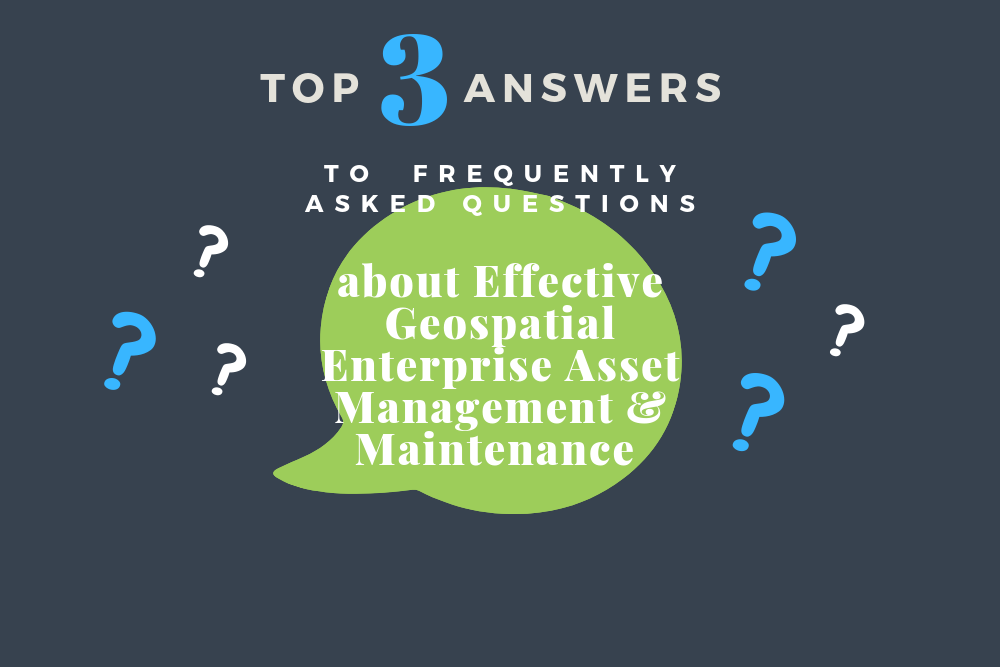
To help other field service organizations learn more about the topic, here are 3 answers to frequently asked questions we get about effective geospatial enterprise asset management.
How do I Maintain and Service Assets Right in the Field? What tools do I need?
It’s common in the enterprise asset management space to be able to visualize assets on a map view or from a geospatial perspective. However, not all EAM solutions are created equal. When we get this particular question, we find it’s best to explain the answer with an analogy.
Your technician is out in the field working on an asset. Maybe they are conducting routine maintenance or inspecting a piece of equipment for weak points. In either case, how did the technician get to that point?
Our answer is combining field service management (FSM) and asset service management is the answer in this scenario. To properly service assets, you need to be able to:
1. Create the asset both within the platform operations managers, dispatchers or supervisors use, as well as from the mobile application the field technician accesses on their mobile device.
2. Schedule recurring maintenance plans on the asset, not just work orders. This is a key component, as it covers both scenarios of either a general work order or a general asset management.
3. Conduct spatial field service operations data analysis on assets. We find this topic so important in FSM and EAM that we blogged about it and we created a visual infographic on the “Time and Space of Field Service Management: 3 Undervalued Benefits of Spatial Field Service Operations Data Analysis,” which I highly recommend reading. To the degree that you can acquire data around your assets, you should because the information can be used to make more informed decisions at all levels of the organization.
4. Easily update the asset database, repository or source of record as updates occur in the field. Part of an overall effective asset management strategy is maintaining accurate asset data. When technicians redline asset updates and submit them for approval, the approved updates should be immediately available wherever the source of record is for the asset data. It’s important for many reasons to maintain an accurate asset database, from locating the asset to knowing when the asset was last serviced. All of this activity impacts effective asset management.
5. Automate the field processes and workflows used to maintain and service assets. Why waste significant time, resources on manual processes when the technology exists to help automate some or all of the steps involved in managing your assets? A platform that has the ability to store geospatial asset information and automate field workflows around those assets is a complete game-changer for field service organizations. We know, we’ve experienced it first hand and one of the reasons our customers love Field Squared.
Is it Possible to Track Fixed and Mobile Assets in Real-Time from the Field and How?
It’s absolutely possible (and crucial) to track fixed and mobile assets in real-time from the field. Leveraging the GPS chip within the mobile device used by field technicians, some FSM/EAM solutions are able to capture the location of assets on a map view. In the context of asset location, it’s extremely useful to understand if and how the location of the asset has changed over time.
The added ability to update location of the asset is a must for most field service organizations, though we are of the belief this type of functionality should come standard in the FSM/EAM solution due to the criticality of effective geospatial enterprise asset management.
How Can I use Augmented Reality (AR) for Asset Service Management?
This is a more future-looking question I was asked a few times more recently. I felt this particular question was interesting enough to share my answer to, even though it’s not yet a frequently asked question.
As we’ve seen and discussed in a past blog post, How Augmented Reality Will Change Field Service Operations, augmented reality in field service, enterprise asset management and mobile workforce management is no longer bleeding edge technology. Today, AR is already beginning to make headways across asset intensive industries or instances where detailed visual planning is a requirement, such as equipment repair/maintenance and construction project management.
What I also tell field service organizations is not to rule out the future use of this complementary technology, because it has the potential to make asset management more efficient. For instance, a technician is working to repair a piece of equipment, but they’ve hit a snag. To help visualize the issue, the technician overlays context-sensitive operating procedures in their field of view while working on the asset. This visualization combined with the step by step procedures and schematics helps the technician to resolve the issue without calling in an engineer or requiring a separate work order. This type of success improves first-time resolution metrics most field service organizations track to measure performance of technicians and overall operations health.
These 3 answers to frequently asked questions about effective geospatial enterprise asset management are just a few of the many topics we work with field service organizations to understand every day. To us, this is why we exist and why we love being the go-to field service and enterprise asset management solution for many organizations.




